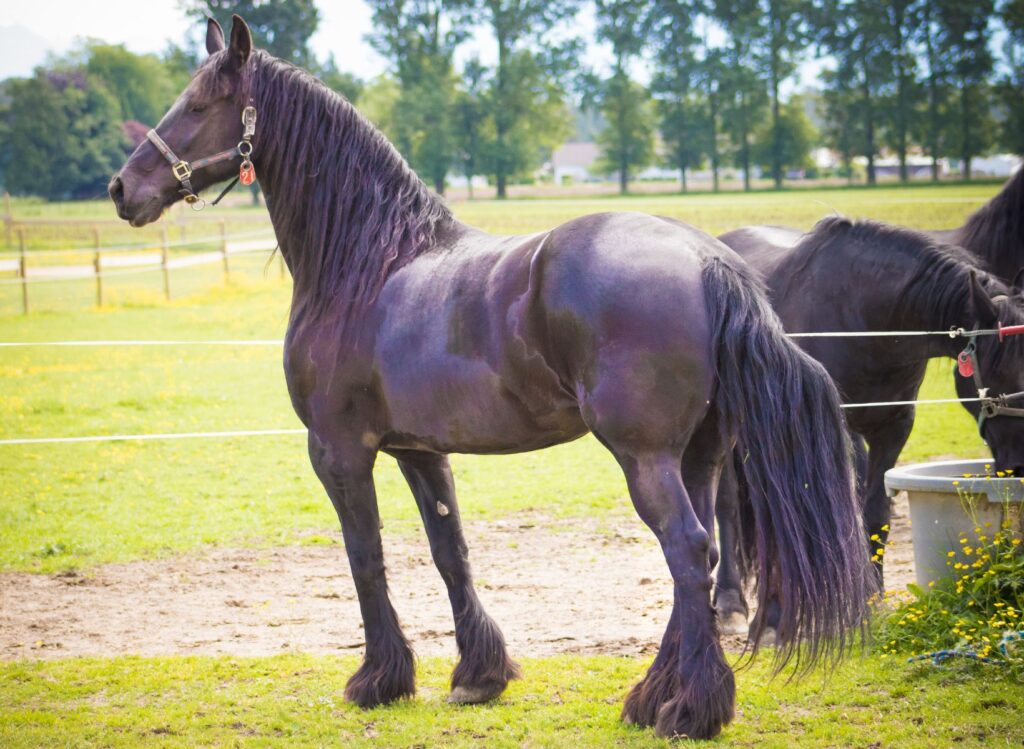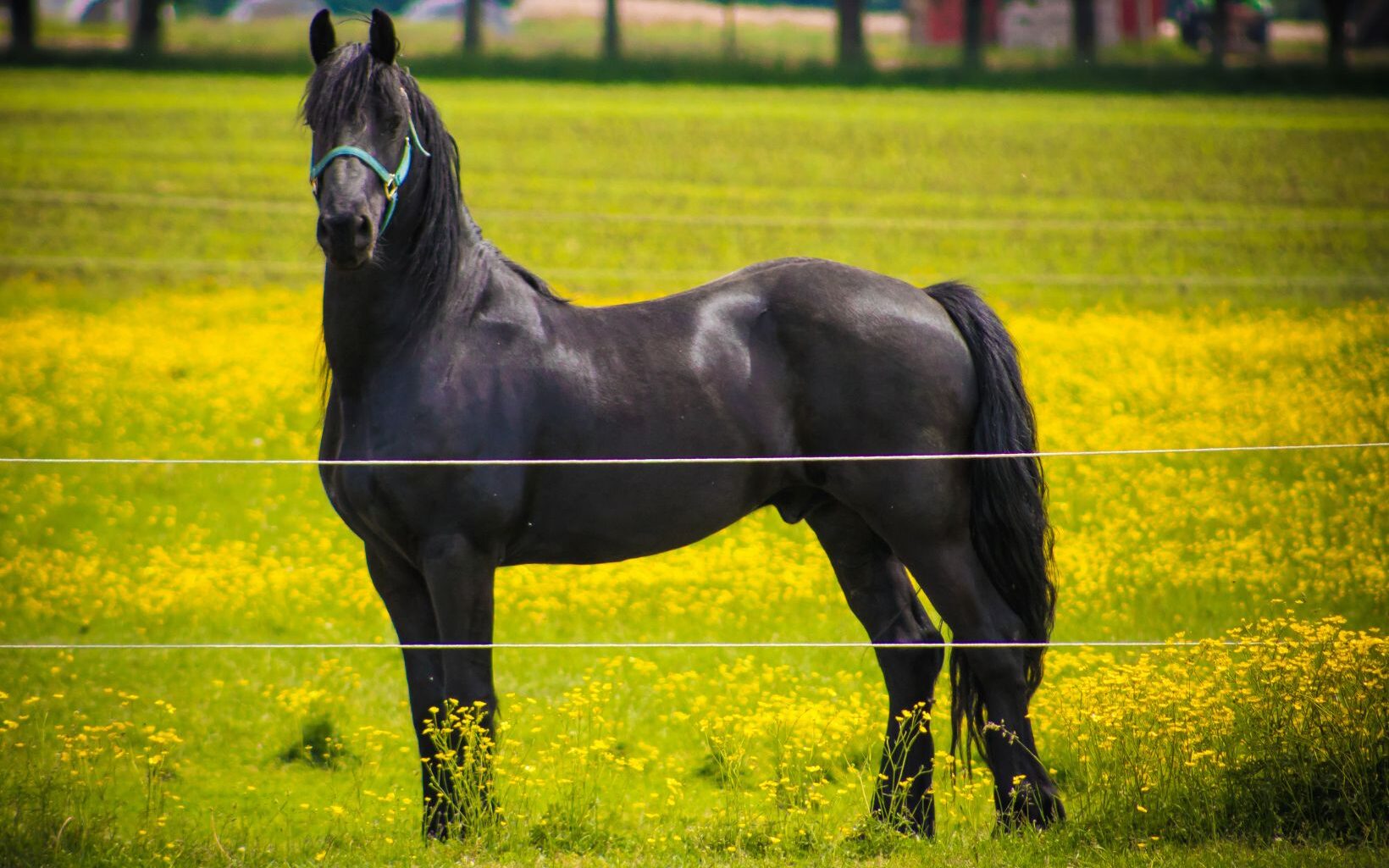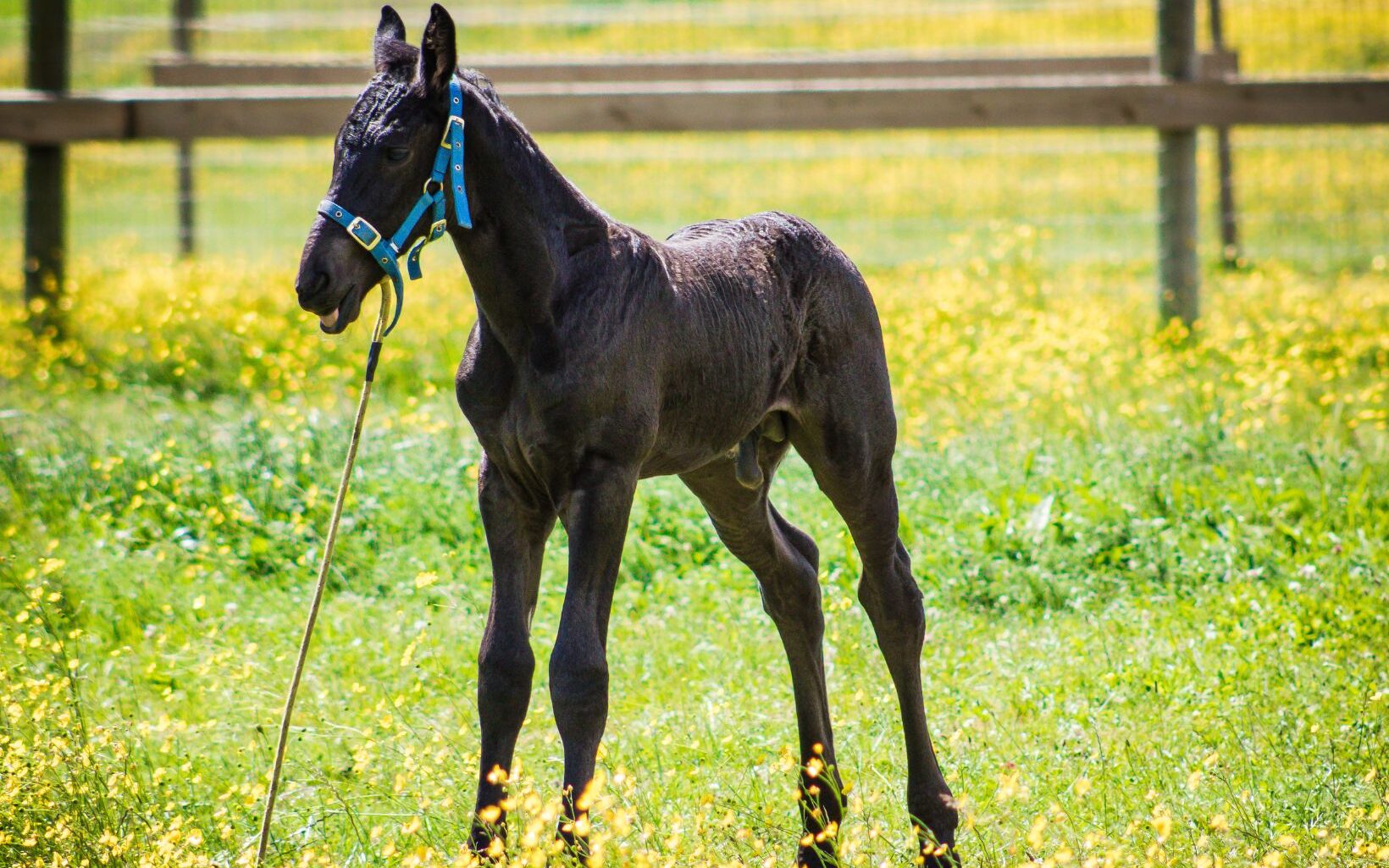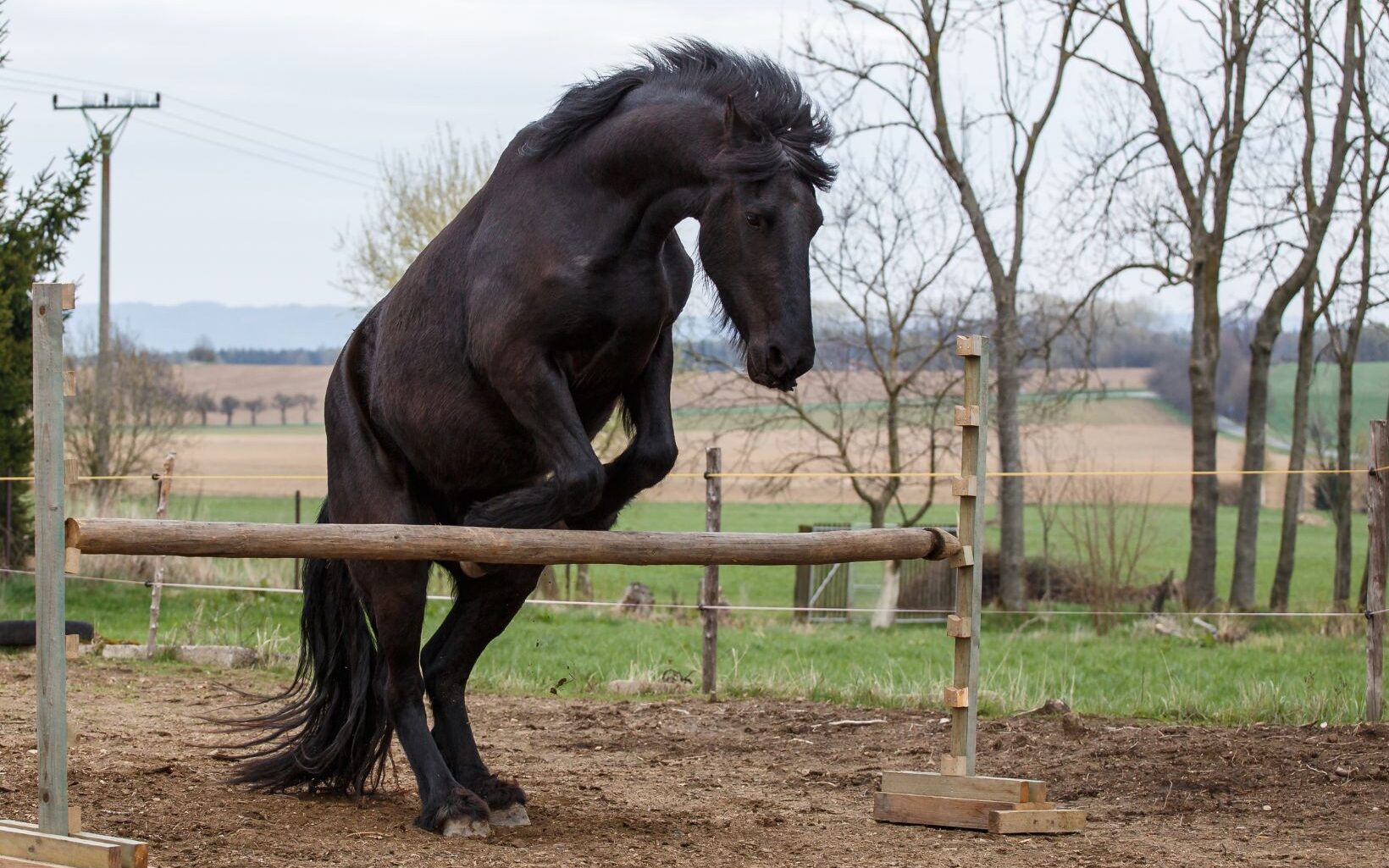Last updated: January 19, 2024
Have you ever been captivated by the elegance of a Friesian horse? As a seasoned horse enthusiast, I’ve long been fascinated by their rich history. These majestic horses embody beauty and strength; they also boast a variety of types, each with its own uniqueness. But what exactly sets these different types apart?
In this article, we’ll explore Friesian horses, both the traditional type, known for its classic beauty and historical significance and the Friesian Sport Horse, a more recent evolution tailored for modern equestrian sports. Join me on this journey to discover the distinct qualities that make each type of Friesian horse unique and cherished among horse lovers.

Traditional Friesian Horse. Source: Annalisa Parisi, CC BY-SA 3.0
The Traditional Friesian Horse (Baroque Friesian Horse)
Often referred to as the Baroque Friesian, the Traditional Friesian Horse is a breed that seamlessly blends historical grandeur with modern elegance. This section unravels the mystique surrounding the original Friesian horse, known for its striking appearance and noble demeanor.
Historical Roots and Evolution
- Origins: Hailing from Friesland in the Netherlands, this breed has a storied past dating back to the Middle Ages.
- War and Nobility: Initially bred for war, these horses later became symbols of status among European nobility.
- Evolution: Over centuries, they evolved from war horses to carriage horses and farm workers.
- Preservation: Nearly faced extinction in the early 20th century but was revived through dedicated breeding efforts.

Physical Characteristics and Temperament
- Iconic Appearance: Recognizable by their shiny black coat, long flowing mane, and feathered legs.
- Stature: Typically standing between 15 to 17 hands, they are well-muscled, typically weighing between 1,100 and 1,500 pounds.
- Build: Muscular body, strong bone structure, and an arched neck.
- Temperament: Known for their calm, gentle nature, making them suitable for riders of various skill levels.
- Gait: Graceful and high-stepping movement, known for their elegance.
Roles and Uses in History and Today
- Historical Roles:
- War horses in the Middle Ages.
- Carriage horses for nobility in the 17th and 18th centuries.
- Farm work, particularly in Friesland.
- Current Uses:
- Dressage: Excel due to their graceful movement and trainability.
- Show: Popular in driving and under saddle classes for their beauty and presence.
- Film and Theatre: Often featured for their striking appearance and noble demeanor.
- Recreational Riding: Loved by equestrians for their gentle nature and versatility.
In this article, I use the terms “Traditional Friesian Horse” and “Baroque Friesian Horse” interchangeably, referring to the same type of horse that has captivated horse enthusiasts for centuries.

The Friesian Sport Horse – A Modern Evolution
The Friesian Sport Horse represents a contemporary twist on the traditional Friesian, blending the breed’s classic beauty with enhanced athleticism and versatility. This section delves into the characteristics, history, and uses of this modern evolution of the Friesian breed.
Characteristics and Athleticism
- Physical Build: The Friesian Sport Horse boasts a lighter build compared to its traditional counterpart, designed for agility and performance.
- Height and Weight: Typically stands between 15.2 and 17 hands tall, weighing between 1,200 and 1,500 pounds.
- Appearance: Features a streamlined look with longer legs and a more upright neck, embodying a blend of strength and elegance.
Emergence and Development
- Historical Emergence: This sportier version of the Friesian emerged in the 1980s, marking a significant shift in breeding goals.
- Crossbreeding for Agility: Developed through the strategic crossbreeding of traditional Friesians with other breeds, focusing on enhancing agility and adaptability.
Contemporary Roles and Achievements
- Versatility in Equestrian Sports: Excelling in disciplines like dressage, jumping, and eventing, the Friesian Sport Horse has carved out a niche in competitive equestrian sports.
- Contribution to New Breeds: Their unique attributes have made them ideal for crossbreeding, leading to the creation of new combinations like the Friesian Sporthorse, further expanding the breed’s influence and versatility. Source
The Friesian Sport Horse stands as a testament to the breed’s adaptability and continued relevance in modern equestrian pursuits, offering a perfect blend of the Friesian’s traditional grace with contemporary performance demands.

Common Traits of All Friesians
Despite their differences, all Friesian horses share several common traits.
- Color: All Friesians are black with no white markings.
- Temperament: Gentle, willing, intelligent, and curious.
- Movement: Elegant and graceful, with a high-stepping gait.
- Feathering: Long hair on lower legs requires regular grooming.
Learn more about the Friesian horse breed.

Preserving the Legacy – Breeding and Registry
In the world of Friesian horses, the art of breeding and the role of registries are not just about maintaining a lineage; they are about preserving a legacy. This section delves into the critical importance of breed registries like the Koninklijke Friesch Paarden-Stamboek (KFPS) and the ethical practices that underpin the breeding of Friesians.
The Role of Breed Registries
- KFPS (Koninklijke Friesch Paarden-Stamboek): The primary registry for Friesian horses, established in the Netherlands.
- Standard Preservation: KFPS plays a crucial role in maintaining the breed’s purity and standardizing characteristics.
- Global Influence: Oversees international breeding programs, ensuring global adherence to Friesian horse standards.
- Record Keeping: Maintains extensive records of pedigrees, breeding outcomes, and health data to guide breeding decisions.
Ethical Breeding Practices
- Pure Bloodline Preservation: Emphasizes the importance of breeding purebred Friesians to maintain the breed’s unique traits.
- Health and Welfare: Focuses on the health and well-being of the horses, avoiding practices that could compromise their quality of life.
- Genetic Diversity: Encourages responsible breeding practices to ensure genetic diversity and prevent hereditary health issues.
- Education and Guidelines: Provides resources and guidelines to breeders on ethical and sustainable breeding practices.
As stewards of their heritage, breeders and registries play a pivotal role in ensuring that the qualities of the Friesian horse are not just retained but also celebrated for generations to come.

Riding a Friesian. Source Duguyue100, CC BY-SA 4.0
Conclusion
The Friesian horse, with its majestic presence and rich history, continues to captivate the hearts of equestrians and horse enthusiasts around the world. From the traditional Friesian, embodying the breed’s historical elegance and strength, to the modern Friesian Sport Horse, showcasing agility and versatility, these horses are a testament to both their enduring legacy and adaptability to contemporary equestrian needs.
Their unique combination of beauty, temperament, and performance makes them not only a favorite in various disciplines but also a symbol of equine grace and power. As we have explored, the preservation of this breed through ethical breeding practices and the meticulous efforts of registries like the KFPS ensures that the Friesian horse continues to thrive and enchant future generations.
Whether admired for their roles in history, their achievements in sports, or simply their breathtaking appearance, Friesian horses remain an integral and beloved part of the equestrian world.
Additional Resources
For those interested in delving deeper into the world of Friesian horses, the following resources offer a wealth of information:
- Koninklijke Friesch Paarden-Stamboek (KFPS)
- Friesian Horse Association of North America (FHANA)
- The Friesian Horse Society (FHS)
- International Friesian Show Horse Association (IFSHA)
These resources provide comprehensive insights into the breed’s history, breeding standards, and their role in equestrian sports and culture.

Conclusion
In the world of equine majesty, Friesian horses stand out as a breed of remarkable beauty, versatility, and history. From the robust and versatile Traditional Friesian Horse, known for its strength and powerful gait, to the elegant and regal Baroque Friesian Horse with its noble carriage heritage, and the athletic and agile Sport Horse Friesian, each type brings its own unique qualities and rich history to the equestrian world.
Despite their diverse applications and physical differences, all Friesians share common traits that make them a beloved and easily recognizable breed. Their striking black color, gentle temperament, graceful movement, and distinctive feathering are hallmarks of the breed.
The role of the Koninklijke Vereniging “Het Friesch Paarden-Stamboek” (KFPS) in preserving the purity and legacy of these magnificent horses cannot be overstated. As the official breed registry, the KFPS ensures that the Friesian horse continues to thrive and evolve while maintaining the breed’s integrity and historical significance.
Here is a good YouTube video showing Friesian horses playing.
Additional Resources and Friesian Horse Associations
Friesian horse enthusiasts, owners, and prospective buyers can find a wealth of information, support, and community through various associations and resources dedicated to this magnificent breed. Here are some key organizations and online resources:
Friesian Horse Association of North America (FHANA)
- About: FHANA is dedicated to preserving and promoting the Friesian horse breed in North America.
- Services: They offer registration, breed information, events, and support for Friesian horse owners and breeders.
- Website: FHANA
The Friesian Horse Society (FHS)
- About: FHS focuses on the registration and preservation of the Friesian horse’s pure bloodlines.
- Services: They provide registration DNA testing and promote the breed through various events and shows.
- Website: FHS
Koninklijke Vereniging “Het Friesch Paarden-Stamboek” (KFPS)
- About: The KFPS is the original Dutch Friesian Horse registry, founded in the Netherlands.
- Services: They are responsible for the studbook, breeding, and promotion of Friesian horses globally.
- Website: KFPS
International Friesian Show Horse Association (IFSHA)
- About: IFSHA is the official United States Equestrian Federation (USEF) recognized representative of the Friesian horse.
- Services: They organize and oversee Friesian horse shows and competitions in the USA.
- Website: IFSHA
Friesian Horse Association of Great Britain & Ireland (FHAGBI)
- About: FHAGBI aims to promote and protect the interests of Friesian horses in the UK and Ireland.
- Services: They offer membership, horse registration, and organize events and shows.
- Website: FHAGBI
These associations provide valuable resources for anyone interested in Friesian horses, whether for ownership, breeding, competition, or simply as admirers of the breed. They offer a platform for learning, sharing, and connecting with others who share a passion for Friesian horses.
FAQs: Types of Friesian Horses
How rare is a Friesian horse?
Friesian horses are considered to be a rare breed, with an estimated worldwide population of only around 60,000 purebred Friesians. However, they are not on the Livestock Conservancy’s priority watch list.
Why are Friesian horses so expensive?
Friesians are expensive because they are relatively rare, have a striking appearance and gentle temperament, and require significant investment in training and care. Elite and rare bloodlines command high prices, with some top-quality Friesians selling for hundreds of thousands of dollars.

About the Author: Miles Henry
Lifelong Horseman | Racehorse Owner | Published Author
Miles Henry brings over 25 years of hands-on experience training and owning Thoroughbred racehorses. Raised with Quarter Horses and Appaloosas, he’s spent a lifetime learning from horses—on the track, in the barn, and in the field. Today, he runs a small but successful racing stable in Louisiana and shares real-world insights on HorseRacingSense.com, helping horse owners, fans, and bettors navigate the sport with confidence.
📚 Books: View Miles’s books on Amazon »
🎧 Podcast Guest: Animal Tales Ep. 32 |
YouTube Interview
📩 Newsletter: Sign up for racing tips and horse care advice »
🔗 Follow Miles:
Twitter |
Facebook |
YouTube


